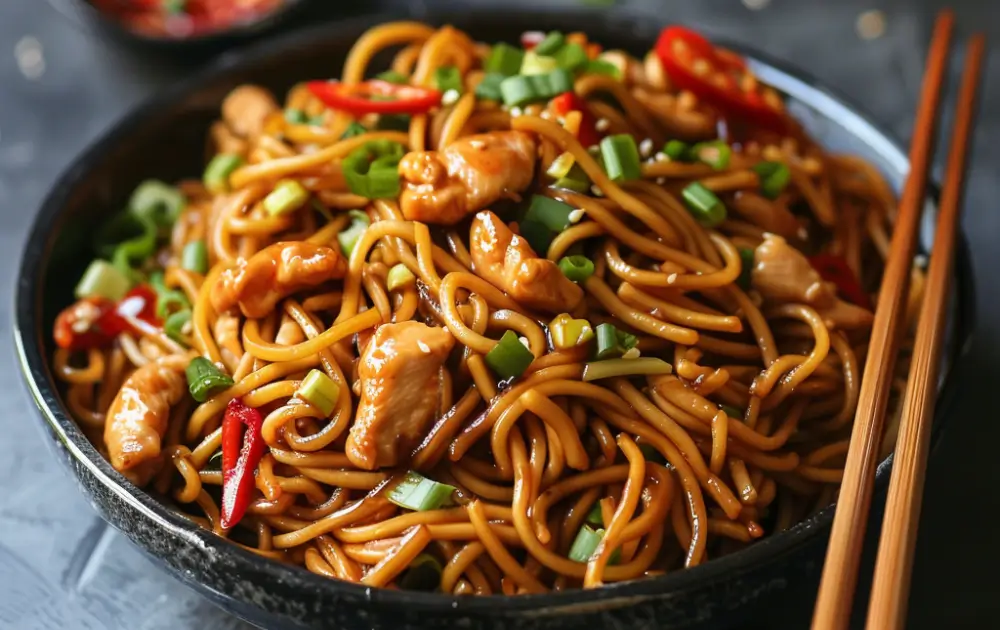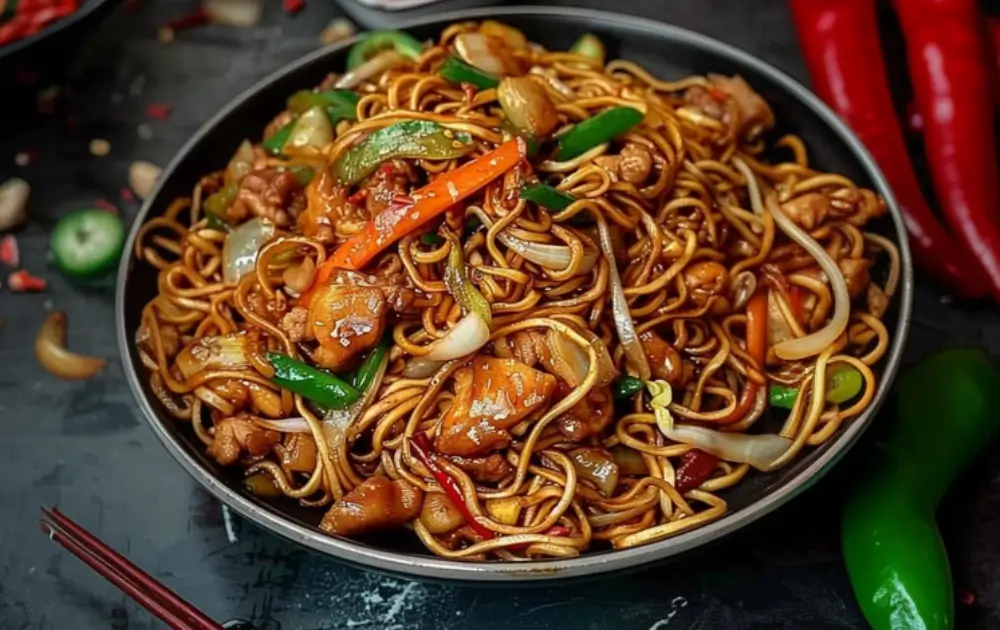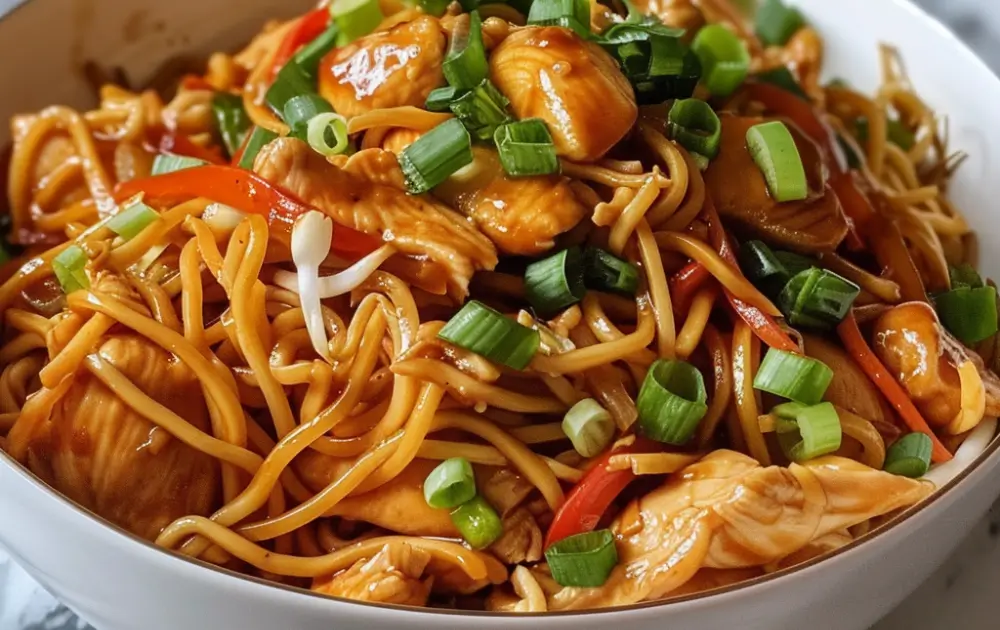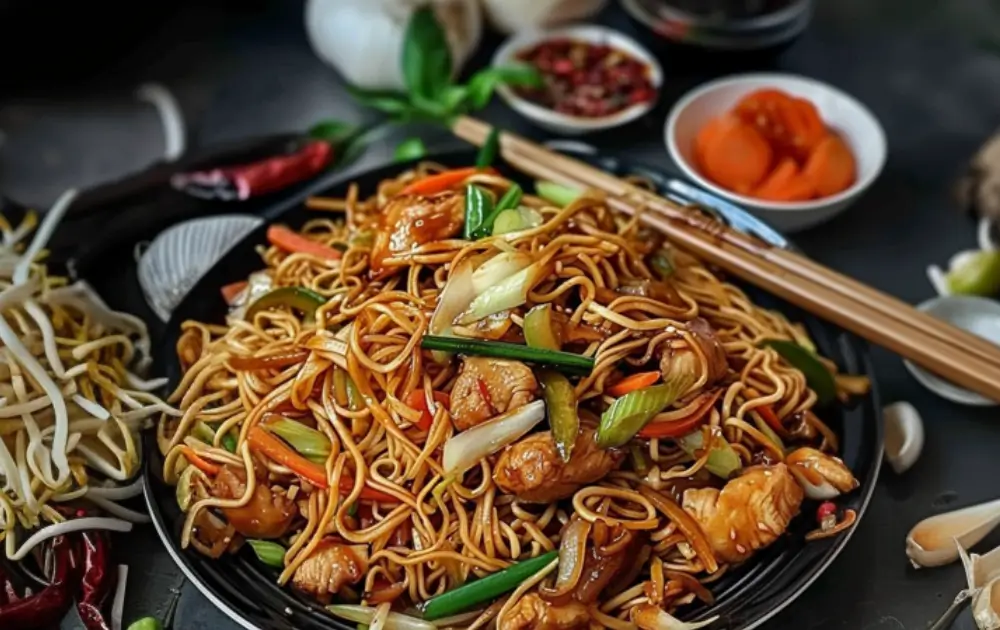Mastering Chicken Chow Mein: A Step-by-Step Guide to the Perfect Stir-Fry
Introduction
Chicken Chow Mein is a classic Chinese dish that has gained popularity worldwide for its savory flavors and versatility. It consists of stir-fried noodles tossed with chicken, vegetables, and a rich sauce that typically includes soy sauce, oyster sauce, and sesame oil. This dish is not only a staple in Chinese restaurants but is also a favorite for home cooking because it can be easily adapted to include a variety of ingredients depending on personal tastes and dietary requirements.
Print
Chicken Chow Mein
- Total Time: 35 minutes
- Yield: 4
Description
Chicken Chow Mein is a beloved Chinese stir-fry noodle dish that features tender chicken, crisp vegetables, and flavorful noodles in a savory sauce. This dish is celebrated for its delightful texture and rich taste, making it a popular choice in both home kitchens and restaurants worldwide.
Ingredients
-
2 chicken breasts, thinly sliced
-
2 tablespoons soy sauce
-
1 tablespoon honey
-
1 onion, sliced
-
2 carrots, julienned
-
1 red bell pepper, sliced
-
2 cups cabbage, shredded
-
2 garlic cloves, minced
-
2 tablespoons oyster sauce
-
200g (7 oz) chow mein noodles
-
2 green onions, chopped for garnish
-
Optional: sesame seeds for garnish
Instructions
-
Marinate the Chicken:In a bowl, combine thinly sliced chicken breasts with soy sauce and honey. Set aside to marinate for 10 minutes.
-
Prepare Noodles:Cook chow mein noodles according to package instructions. Once cooked, drain and set aside.
-
Stir-Fry Vegetables:Heat oil in a large pan or wok over medium-high heat. Add minced garlic and sliced onion, cook until fragrant.
Add julienned carrots, sliced red bell pepper, and shredded cabbage. Stir-fry until vegetables are tender yet crisp. -
Cook Chicken:Push vegetables to one side of the pan, add marinated chicken to the empty side. Cook until chicken is no longer pink and fully cooked.
-
Combine and Season:Mix vegetables and chicken together. Add oyster sauce and toss until everything is evenly coated.
-
Add Noodles:Add cooked chow mein noodles to the pan. Toss with the chicken and vegetable mixture until well combined and heated through.
Notes
- Ensure not to overcook the vegetables to maintain their crunch.
- Adjust the soy sauce and oyster sauce according to your taste preference for saltiness and umami.
- Prep Time: 15 minutes
- Cook Time: 20 minutes
- Category: Main Course
- Method: Stir-frying
- Cuisine: Chinese
Nutrition
- Calories: 350
- Sugar: 5g
- Fat: 12g
- Carbohydrates: 35g
- Fiber: 3g
- Protein: 25g
- Cholesterol: 55mg
Frequently Asked Questions about Chicken Chow Mein
- What type of noodles are best for Chicken Chow Mein? Traditional Chow Mein uses egg noodles, which are parboiled, drained, and then stir-fried until crispy. However, you can use any type of noodle you prefer, including fresh, dried, or even spaghetti as a substitute.
- Can I make Chicken Chow Mein ahead of time? Yes, you can prepare Chicken Chow Mein ahead of time and refrigerate it. For the best results, reheat it in a pan over medium heat to restore the texture of the noodles and reinvigorate the flavors.
- How can I make my Chicken Chow Mein gluten-free? To make gluten-free Chicken Chow Mein, use tamari instead of regular soy sauce and ensure your noodles are gluten-free, such as rice noodles or certified gluten-free egg noodles.
- What vegetables can I add to Chicken Chow Mein? Common vegetables in Chow Mein include carrots, cabbage, onions, and bell peppers. You can also add snow peas, bean sprouts, or bok choy for more variety and crunch.
- Is there a way to make Chicken Chow Mein spicier? Absolutely! Add chili sauce, fresh sliced chilies, or extra pepper flakes while cooking to bring more heat to the dish.
Key Ingredients and Variations
The foundation of Chicken Chow Mein is its noodles, usually made from wheat and egg. The chicken is often marinated beforehand to enhance its flavor and tenderness. Common vegetables in the mix include cabbage, carrots, onions, and bell peppers, all sliced for quick cooking. Variations might include the addition of bamboo shoots, water chestnuts, or bean sprouts for extra crunch and nutritional value. For those who like a bit of heat, a dash of chili oil or fresh sliced chilies can be included.
Preparation Techniques
Preparing Chicken Chow Mein involves several key steps to ensure each component is cooked perfectly. The noodles are typically boiled or soaked until just tender and then drained well. Meanwhile, the chicken slices are stir-fried until golden and set aside. Vegetables are then stir-fried in a high-heat wok until they begin to soften but still retain some crunch. Finally, everything is combined back in the wok, including the noodles and sauce, and stir-fried together to allow the flavors to meld.
Serving Suggestions
Chicken Chow Mein is best served hot directly from the wok. It can stand alone as a hearty meal or be paired with other Chinese dishes for a more elaborate dining experience. Some popular accompaniments include dim sum, spring rolls, or a simple cucumber salad to refresh the palate. For a balanced meal, consider adding a side of steamed broccoli or a light soup.
Cultural Significance and Popularity
Originally from the Canton region of China, Chow Mein has evolved and been embraced in many different countries, each adding its local twist. In the West, it is often one of the most requested dishes in Chinese takeout and is celebrated for its delicious taste and quick preparation time. The adaptability and quick cooking time of Chicken Chow Mein have made it a popular choice for busy weeknights and family gatherings alike, showcasing its enduring appeal across diverse culinary cultures.

Nutritional Benefits
Chicken Chow Mein can be a nutritious option, especially when loaded with a variety of vegetables. Chicken provides a lean source of protein which is essential for muscle repair and growth. The vegetables add dietary fiber, vitamins, and antioxidants, making the dish both filling and beneficial for health. To increase its nutritional value, one could use whole wheat noodles or swap them for a low-carb alternative like zucchini noodles. Additionally, reducing the sodium content by using low-sodium soy sauce or a soy sauce substitute can make it a healthier choice for those monitoring their salt intake.
Cooking Tips for the Best Chow Mein
Achieving the perfect Chicken Chow Mein involves a few handy cooking tips. First, it’s important to cook the noodles until they are just al dente to prevent them from becoming soggy when stir-fried with the other ingredients. Secondly, using a well-seasoned wok and high heat can give the vegetables and meat a slightly smoky flavor, enhancing the overall taste of the dish. Make sure to stir-fry the ingredients quickly to retain their texture and nutrients. Lastly, adjusting the seasoning before the final stir-fry allows for a well-balanced dish.
Creative Leftover Ideas
Chicken Chow Mein leftovers can be creatively used to make new meals. They can be transformed into a Chow Mein noodle salad by adding fresh vegetables and a light soy or sesame dressing, served either cold or at room temperature. Another idea is to wrap the leftovers in a flour tortilla to make a fusion-style burrito. Alternatively, adding a beaten egg to the reheated Chow Mein can turn it into a flavorful noodle omelette, giving the leftovers a completely new texture and taste profile.
Hosting and Serving at Events
Chicken Chow Mein is an excellent dish for hosting large gatherings or events. It’s relatively easy to make in large quantities and can be kept warm in buffet settings without losing its texture or flavor. For a more interactive experience, hosts can set up a noodle bar where guests choose their own vegetables and proteins to be stir-fried by a chef, offering a personalized meal. Additionally, serving it alongside other Asian-inspired dishes such as fried rice, dumplings, and sweet and sour chicken can offer guests a variety of flavors and enhance the dining experience.
Adapting for Dietary Restrictions
Adapting Chicken Chow Mein to meet various dietary restrictions can easily be done without sacrificing flavor. For gluten-free requirements, use tamari or a gluten-free soy sauce instead of traditional soy sauce and ensure the noodles are gluten-free as well. If you want a vegetarian version, omit the chicken and add tofu or a greater variety of vegetables. To avoid added sugar, ensure that no sugar-containing sauces are used. These adaptations allow individuals with specific dietary needs to enjoy a customized version of this beloved dish.

Incorporating Local Ingredients
Utilizing local ingredients in Chicken Chow Mein can elevate the dish while supporting local producers. Chefs and home cooks can incorporate seasonal vegetables grown nearby, which can enhance the freshness and flavor of the dish. For example, using locally sourced mushrooms, green onions, or even local artisan soy sauces can make a noticeable difference in taste. This not only promotes sustainability but also introduces diners to regional flavors, making each dish unique. By highlighting these local ingredients on menus or in recipes, cooks can showcase their commitment to quality and community support.
Enhancing Flavors with Specialty Oils
Experimenting with different oils can add a new dimension of flavor to Chicken Chow Mein. Sesame oil, with its nutty aroma, is a traditional choice that complements the savory elements of the dish. However, trying other specialty oils, such as chili oil for a bit of heat or walnut oil for a subtle, nutty undertone, can personalize and enhance the profile of the Chow Mein. Introducing these oils during the final stages of cooking helps preserve their flavors and health benefits, providing a richer experience with each bite.
Educational Cooking Classes
Offering cooking classes focused on making Chicken Chow Mein can be a fun and educational way to engage with the community. These classes can teach important stir-frying techniques, the benefits of ingredient diversity, and how to balance flavors to achieve the perfect dish. Furthermore, participants can learn about the nutritional aspects of Chicken Chow Mein, making it a valuable dish for those looking to cook healthily at home. Such classes can be offered in community centers, cooking schools, or as part of culinary events, enhancing participants’ cooking skills and their appreciation for Chinese cuisine.
Marketing Strategies for Restaurants
Restaurants can boost their appeal by featuring Chicken Chow Mein prominently on their menus, especially if they use unique or high-quality ingredients. Marketing the dish through social media, with attractive photos and engaging posts about its preparation and ingredients, can draw in diners. Special promotions, like “Chow Mein Tuesdays,” can increase weekday sales, while offering customizable versions of the dish can appeal to a broader audience, including those with dietary restrictions. By emphasizing the dish’s versatility and appeal, restaurants can attract a diverse clientele looking for both comfort and innovation in their meals.
Cultural Festivals and Events
Chicken Chow Mein can play a central role in cultural festivals and culinary events, where it can be used to showcase Chinese culinary traditions. During such events, demonstrations of Chow Mein preparation can attract attendees interested in the culinary arts, and tastings can introduce people to authentic Chinese flavors. Additionally, incorporating Chow Mein in a multicultural food expo can help illustrate the dish’s adaptability and how it has influenced, and been influenced by, other cuisines around the world. This not only celebrates the dish but also fosters a greater appreciation for cultural exchange through food.

Sustainability in Cooking Practices
Implementing sustainable cooking practices with Chicken Chow Mein can significantly impact environmental conservation. Opting for organic and locally sourced ingredients reduces the carbon footprint associated with food transportation and supports local agriculture. Utilizing every part of the vegetables, such as using broccoli stems along with the florets, helps minimize waste. Additionally, chefs can educate consumers about the importance of sustainable eating through menu descriptions or informational pamphlets that highlight the ecological benefits of the ingredients used in their Chow Mein. This not only enhances the dining experience but also aligns with the growing consumer interest in environmentally responsible dining options.
Pairing with Beverages for Enhanced Dining Experience
To elevate the dining experience, pairing Chicken Chow Mein with appropriate beverages can make a significant difference. Light-bodied white wines, like Sauvignon Blanc or a crisp Pinot Grigio, can complement the dish’s flavors without overwhelming them. For non-alcoholic options, green tea or jasmine tea offers a traditional complement that can help cleanse the palate between bites, enhancing the flavors of the meal. Offering these pairing suggestions on menus or in dining settings can guide guests towards a more enjoyable and harmonious meal.
Expanding Menu Offerings with Variations of Chow Mein
Restaurants can expand their menu offerings by introducing variations of Chicken Chow Mein to cater to diverse tastes and dietary preferences. Incorporating different proteins like shrimp or beef, or even vegan options such as tofu or tempeh, can attract a wider audience. Offering spicy versions or incorporating unique ingredients like Szechuan peppers or Thai basil can appeal to guests seeking new flavors. These variations not only keep the menu exciting but also demonstrate the kitchen’s culinary range and adaptability.
Utilizing Leftovers Creatively
Creative use of leftovers from Chicken Chow Mein can enhance resource efficiency in the kitchen. Leftover Chow Mein can be transformed into a new meal, such as a Chow Mein frittata or a stir-fried rice dish, by adding a few ingredients. This approach not only reduces food waste but also provides consumers with innovative ideas for home cooking. Restaurants and chefs can share these tips through social media or cooking blogs, helping to build a community interested in sustainable and creative cooking practices.
Hosting Interactive Food Events
Restaurants and culinary schools can host interactive food events centered around Chicken Chow Mein to engage with the community. Live cooking demonstrations, Chow Mein cook-offs, and interactive stir-fry stations where guests can choose their ingredients can make for engaging and educational experiences. These events can also highlight the cultural significance of Chow Mein, offering a deeper understanding of its origins and variations. By involving guests in the cooking process, these events create memorable experiences that can increase customer loyalty and interest in culinary arts.
Conclusion
Chicken Chow Mein is a versatile, delicious dish that serves as a cornerstone in Chinese cuisine and beyond. With its savory flavors and satisfying textures, it’s a favorite that can be easily adapted to suit different tastes and dietary needs. Whether you’re enjoying it as a quick weeknight dinner or serving it at a festive gathering, Chicken Chow Mein offers a delightful blend of nutrition and flavor. Its ability to incorporate a variety of ingredients also makes it a perfect dish for experimenting with new vegetables, proteins, and spices. Embrace the simplicity and adaptability of Chicken Chow Mein and make it a staple in your culinary repertoire.

